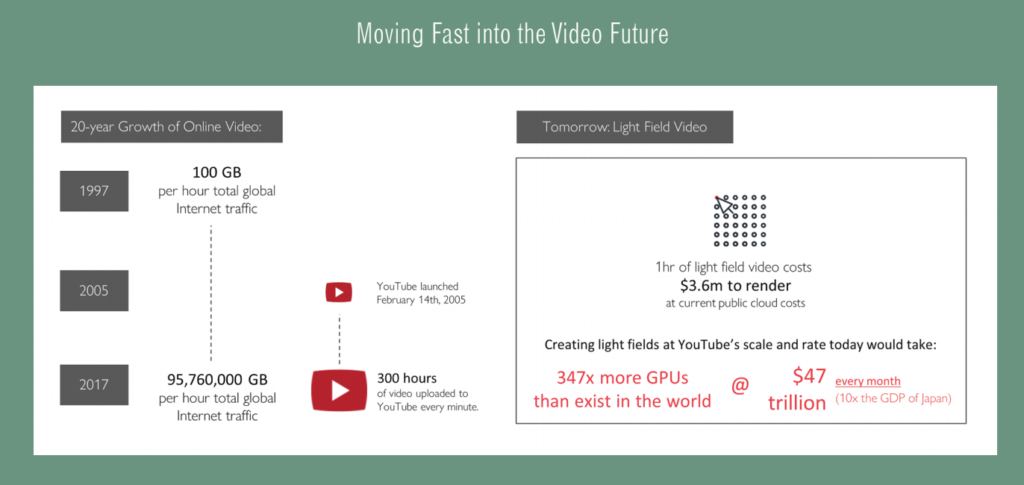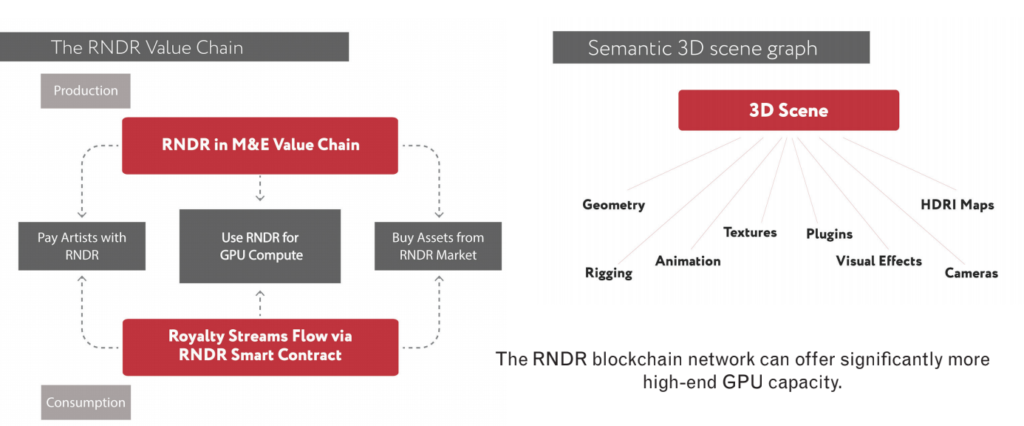Connections

M&E Journal: A Holographic Future: Creating and Monetizing the Next Generation of Media Using Blockchain
Story Highlights
By Kalin Stoyanchev, VP Blockchain and Distributed Systems, and Phillip Gara, Director Strategic Planning, OTOY –
The M&E industry has historically been a pioneer in commercializing large-scale technological innovation – from the printing press to wireless communication (radio, TV, satellite). It is only recently, with the rise of the internet, that the industry has been seen as a late-adopter.
Today, we are on the cusp of two large-scale transformations — virtualization and decentralization — that will create a new era of virtual and mixed reality holographic media. The M&E industry can again take leadership in innovation, bridging the gap between the promise of these breakthroughs and widespread access to them.
Anatomy of a revolution
Over the past 20 years, we have seen an explosion of digital content. Total internet traffic has increased nearly 100,000 times, making HD internet video now available for billions of users on virtually any device. This extraordinary growth has been driven by internet 3.0 cloud infrastructure developed over the past decade.
Today, we are facing a new inflection point with the emergence of volumetric mixed reality and light field technology. By 2021, Cisco projects a 20 times increase in virtual and augmented reality traffic (Visual Networking Index). It will transform the M&E industry, alongside sectors from fashion and retail to scientific research, architecture, and design. Fully photorealistic 3D holograms that naturally blend into our field-of-view will erase boundaries between the digital and the physical worlds, creating an era of spatially rich computing that reshapes everything from commerce to communication.
This will be powered by the artificial intelligence — like the AI-accelerated real-time path-tracing we are developing in OctaneRender — which combines real-time responsiveness with spectrally- correct computer-generated graphics.
 To support this media, resolution will increase exponentially from 4K to gigapixels as light field and mixed reality displays get commercialized.
To support this media, resolution will increase exponentially from 4K to gigapixels as light field and mixed reality displays get commercialized.
Formats will transition from rasterized containers into fully-explodable, semantically-rich 3D data sets, creating lifelike interactive experiences rendered with full physical accuracy.
Film and game production will synthesize into an end-to-end workflow using AI-enabled ray tracing GPUs and the integration of cinematic path-tracing into game engines like Unity3D and Unreal Engine. Finally, distribution and monetization will become more flexible as mixed reality media takes the industry to post-subscription, post-app models.
Just as the emergence of the cloud was central to Web 3.0, blockchain-based decentralized protocols are foundational for disruptive services and platforms to evolve in this post-mobile world of immersive media. Blockchain helps remove key infrastructure and monetization frictions. Globally distributed peer-to-peer networking enables more efficient coordination of compute supply and demand, building orders of magnitude greater GPU cloud scale.
As production is democratized, programmable smart contracts can embed intelligence into 3D data streams, opening up more flexible frameworks for complex holographic digital rights management (DRM) and real-time micro-consumption. The combination of blockchain peer-to-peer compute scaling and smart contract logic will set the foundations for a new era of holographic media.
Decentralized GPU infrastructure
As developers of the OctaneRender Cloud rendering service, we have seen the challenges in scaling the GPU cloud. Unquestionably, the cloud has been revolutionary, providing M&E organizations elasticity to scale on-demand. A centralized model works well for 2K and 4K. However, a new approach is needed for the revolutionary holographic media our partners are developing. Today, a single light field render on the public cloud can cost more than $100,000 and saturate regional availability, causing many producers — including ourselves — to slow production. Multiple renders per day are not sustainable for the markets we are targeting.
With the RNDR blockchain network, we can offer significantly more high-end GPU capacity. The service allows users to contribute their idle GPU power to a decentralized network to accumulate tokens that can then be used on deadline or for scaling to light field resolutions.
This provides perfect GPU CAPEX utilization by minimizing downtime and creates economies of scale by pooling supply and demand. A decentralized marketplace creates pure infrastructure elasticity needed for artists to make production of ultra-high-resolution holographic content economically viable. Our studies show roughly two-thirds of users have their GPUs idle more than half of the time, while more than a third of users have their GPU capacity at idle for more than 75 percent of the time.
Coordinating unused computational supply and unmet demand through a distributed network transforms M&E industry economics at scale.
An intelligent holographic marketplace
In addition to compute efficiency, blockchain technology has evolved to store, validate and time-stamp complex mixes of technical specifications, schedules, accounts, regulations, protocols, standards and property rights. The technology can now track multi-party DRM with time-stamped proof of authorship. For example, smart contracts can attribute artist contributions deep within the history of a 3D object, opening the potential for royalty distributions to producers at all levels of the value chain.
 It also enables a new layer of exchange where both completed 3D works as well as individual elements in the scene graph — textures, scripts, geometry, effects — can be monetized for reuse. With time-stamped proof of authorship and re-composition rights registered on the blockchain and encoded into the logic of 3D scenes, media organizations can frictionlessly license and remix media with full DRM traceability.
It also enables a new layer of exchange where both completed 3D works as well as individual elements in the scene graph — textures, scripts, geometry, effects — can be monetized for reuse. With time-stamped proof of authorship and re-composition rights registered on the blockchain and encoded into the logic of 3D scenes, media organizations can frictionlessly license and remix media with full DRM traceability.
Smart holographic formats allow M&E organizations to unlock new value from IP, creating a complementary, rather than cannibalistic, relationship between open technological innovation and IP protection. On the horizon, we see innovative forms of paid micro-consumption emerging — bypassing burdens of paywalls or downloads and minimizing delay, error and fraud in royalty distributions.
Here are some examples:
Holographic collectibles registered on the blockchain with each instance individually tracked and sold according to programmable logic.
In-game purchases and real-time composition allowing users of open world virtual experiences to create and sell virtual property and IP in a marketplace.
Spatially projected mixed reality holograms exchanged using attention metrics.
Customizable windows for light field streams encoded into smart contracts.
These levels of frictionless production and monetization are needed to produce an era of holographic compute, which pushes the boundary of what is technologically and economically possible. The M&E ecosystem can lead this new wave of innovation.
—-
Click here to translate this article
Click here to download the complete .PDF version of this article
Click here to download the entire Spring/Summer 2018 M&E Journal









